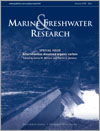
Marine and Freshwater Research
Volume 67 Number 9 2016
Allochthonous Dissolved Organic Carbon
MF15286Increases in humic and bioavailable dissolved organic matter in a forested New England headwater stream with increasing discharge
Movement of dissolved organic matter from terrestrial to aquatic ecosystems represents a transfer of energy of fundamental importance to aquatic microbial food webs. In a headwater stream with homogenous forested land cover, the export of more humic dissolved organic matter increases during hydrologic events and biodegradation experiments indicate the potential for this material to act as a downstream energy source.
MF15371Scale-dependent lateral exchanges of organic carbon in a dryland river during a high-flow experiment
Piggybacking dam releases on high tributary flows can deliver significant environmental benefits to rivers. A small, managed flow revealed a significant input of dissolved organic carbon from river bank to the river channel along a 140-km section of the river. At the same time, there was also significant transport of organic carbon from the river channel to individual floodplain wetlands.
MF14390Carbon and nutrient subsidies to a lowland river following floodplain inundation
Inputs of terrestrial carbon and nutrients from floodplains into rivers is believed to be important to the functioning of lowland rivers. This study demonstrates that carbon in the form of dissolved organic carbon was the major component exported. However smaller amounts of carbon was also exported as invertebrates and algae that potentially could be readily incorporated into food webs
MF15352Transport and transformation of dissolved organic matter in the Neuse River estuarine system, NC, USA, following Hurricane Irene (2011)
Changes in the quantity and quality of dissolved organic matter (DOM) in an estuarine system following a major rain event was examined using optical properties of DOM as a proxy for its chemical properties. A large pulse of terrestrial DOM entered the system that changed from higher to lower molecular weight DOM as it transited through the estuary, presumably caused by photodegradation.
MF15280Dissolved organic carbon and dissolved organic nitrogen concentrations and exports upstream and downstream of the Dallas–Fort Worth metropolis, Texas, USA
Aquatic DOC and DON concentrations in the upper Trinity River upstream and downstream of the Dallas–Fort Worth metropolis in Texas, USA, were highly correlated with medium-density land use. Between 1 and 35% of riverine DOC was contributed by permitted sewage-effluent discharge. The source of DOC and DON from urban non-point sources is currently unknown but may be linked to increased sodium in the river.
MF14230Can tributary in-flows improve the recovery of the dissolved organic carbon regime in a snowmelt river regulated by a large reservoir?
In regulated rivers, tributary organic matter inputs can make a particularly important contribution to the energetic resource base. We examined dissolved organic carbon dynamics below a large reservoir, and found that tributary carbon inputs to the main-stem were detectable but reduced by upstream diversions of tributary water. Our study is an example of the growing consideration of dissolved organic carbon in environmental water delivery and river rehabilitation.
MF15318Open water metabolism and dissolved organic carbon in response to environmental watering in a lowland river–floodplain complex
The influence of environmental watering actions on dissolved organic carbon and open-water productivity within management areas and the adjacent river channel was assessed. The results contribute to our understanding of the role of terrestrial organic material in supporting aquatic food webs in lowland rivers, and demonstrate potential for environmental watering to have a positive influence on riverine productivity during periods of low water availability.
MF15372Lotic bacterioplankton and phytoplankton community changes under dissolved organic-carbon amendment: evidence for competition for nutrients
This study investigated changes in the abundance and composition of microbial populations following allochthonous inputs of dissolved organic matter within streamside mesocosms. We found that input of DOC and inorganic nutrients, at concentrations similar to observed concentrations following freshwater-river inflows, lead to diminished phytoplankton biomass and an increase in the proportion of heterotrophic bacteria, providing evidence of reduced bacterial reliance on phytoplankton-produced carbon, that lead to competition for N and P.
MF15297Zooplankton responses to freshwater inflows and organic-matter pulses in a wave-dominated estuary
Freshwater inflows have a strong influence on estuarine zooplankton communities. Here, we show that large freshwater inflow events such as storms can lead to changes in zooplankton community structure, owing to physical forcing and changes in salinity. Concurrently, large loads to terrestrial organic carbon delivered during these events boost heterotrophic production, providing an increased food resource for zooplankton.
MF15382Restoring dissolved organic carbon subsidies from floodplains to lowland river food webs: a role for environmental flows?
We suggest that historically, dissolved carbon washed from lowland river floodplains during floods was an important energy source for lowland rivers. River regulation, floodplain isolation, and changes in land use have reduced the amount of carbon available to support riverine food webs. We argue that environmental flows could be used to help restore floodplain carbon subsidies back to the river channel.



